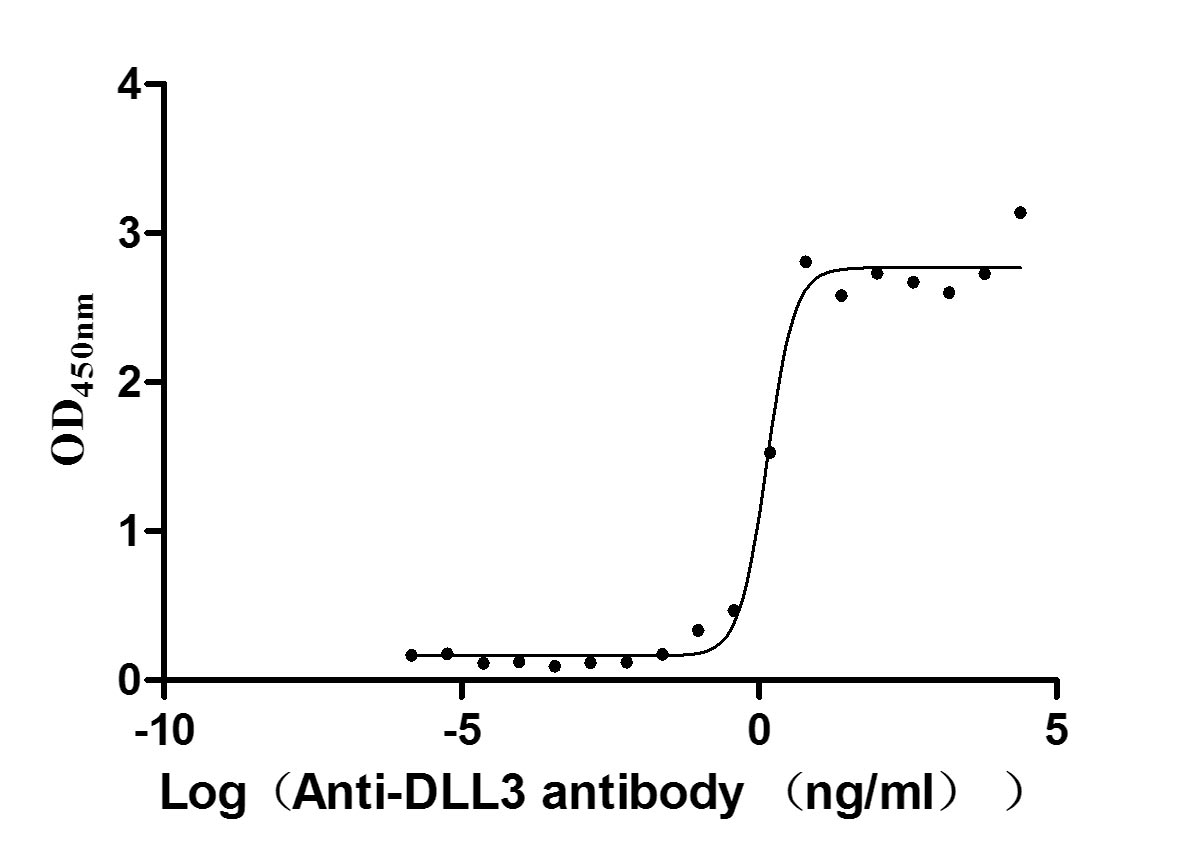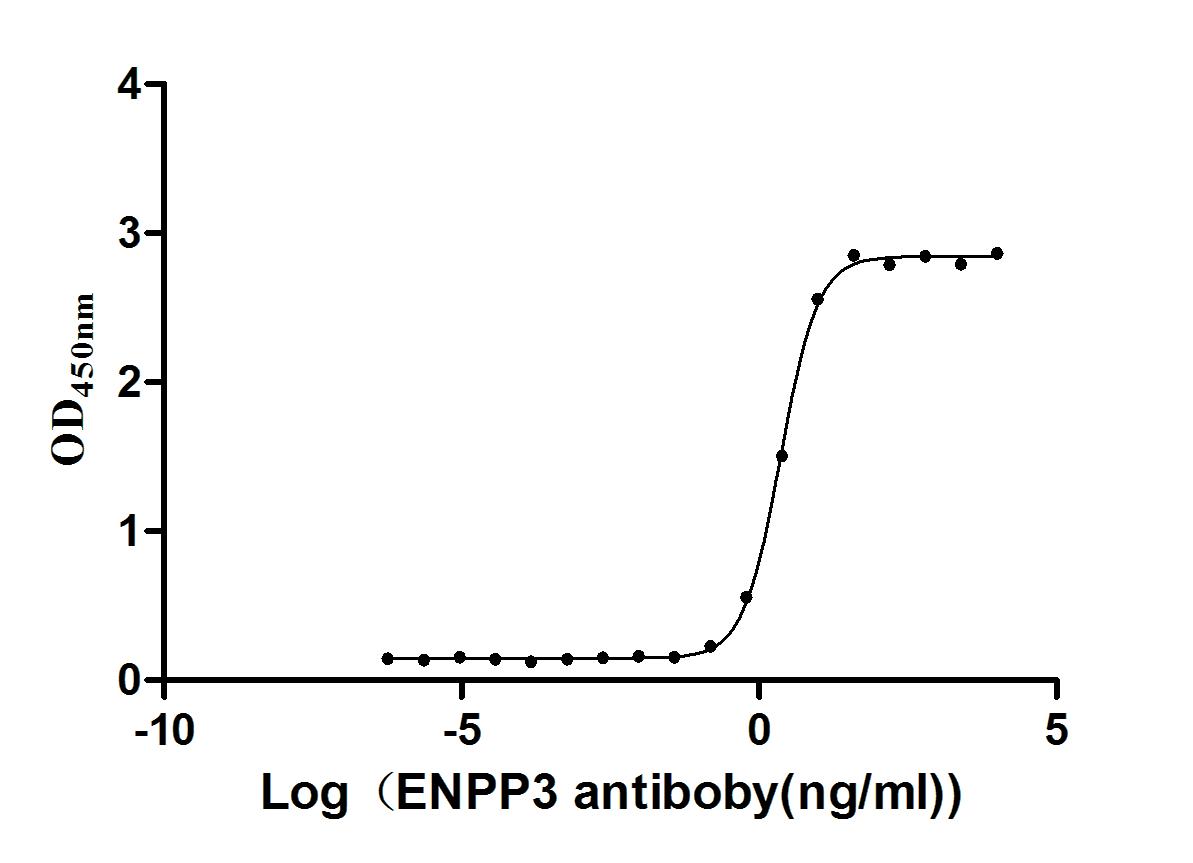Recombinant Mouse Fatty-acid amide hydrolase 1 (Faah), partial
-
中文名称:小鼠Faah重组蛋白
-
货号:CSB-YP007938MO1
-
规格:
-
来源:Yeast
-
其他:
-
中文名称:小鼠Faah重组蛋白
-
货号:CSB-EP007938MO1
-
规格:
-
来源:E.coli
-
其他:
-
中文名称:小鼠Faah重组蛋白
-
货号:CSB-EP007938MO1-B
-
规格:
-
来源:E.coli
-
共轭:Avi-tag Biotinylated
E. coli biotin ligase (BirA) is highly specific in covalently attaching biotin to the 15 amino acid AviTag peptide. This recombinant protein was biotinylated in vivo by AviTag-BirA technology, which method is BriA catalyzes amide linkage between the biotin and the specific lysine of the AviTag.
-
其他:
-
中文名称:小鼠Faah重组蛋白
-
货号:CSB-BP007938MO1
-
规格:
-
来源:Baculovirus
-
其他:
-
中文名称:小鼠Faah重组蛋白
-
货号:CSB-MP007938MO1
-
规格:
-
来源:Mammalian cell
-
其他:
产品详情
-
纯度:>85% (SDS-PAGE)
-
基因名:Faah
-
Uniprot No.:
-
别名:Faah; Faah1; Fatty-acid amide hydrolase 1; Anandamide amidohydrolase 1; Fatty acid ester hydrolase; Oleamide hydrolase 1
-
种属:Mus musculus (Mouse)
-
蛋白长度:Partial
-
蛋白标签:Tag type will be determined during the manufacturing process.
The tag type will be determined during production process. If you have specified tag type, please tell us and we will develop the specified tag preferentially. -
产品提供形式:Lyophilized powder
Note: We will preferentially ship the format that we have in stock, however, if you have any special requirement for the format, please remark your requirement when placing the order, we will prepare according to your demand. -
复溶:We recommend that this vial be briefly centrifuged prior to opening to bring the contents to the bottom. Please reconstitute protein in deionized sterile water to a concentration of 0.1-1.0 mg/mL.We recommend to add 5-50% of glycerol (final concentration) and aliquot for long-term storage at -20℃/-80℃. Our default final concentration of glycerol is 50%. Customers could use it as reference.
-
储存条件:Store at -20°C/-80°C upon receipt, aliquoting is necessary for mutiple use. Avoid repeated freeze-thaw cycles.
-
保质期:The shelf life is related to many factors, storage state, buffer ingredients, storage temperature and the stability of the protein itself.
Generally, the shelf life of liquid form is 6 months at -20°C/-80°C. The shelf life of lyophilized form is 12 months at -20°C/-80°C. -
货期:Delivery time may differ from different purchasing way or location, please kindly consult your local distributors for specific delivery time.Note: All of our proteins are default shipped with normal blue ice packs, if you request to ship with dry ice, please communicate with us in advance and extra fees will be charged.
-
注意事项:Repeated freezing and thawing is not recommended. Store working aliquots at 4°C for up to one week.
-
Datasheet :Please contact us to get it.
相关产品
靶点详情
-
功能:Catalyzes the hydrolysis of endogenous amidated lipids like the endocannabinoid anandamide (N-(5Z,8Z,11Z,14Z-eicosatetraenoyl)-ethanolamine), as well as other fatty amides such as the taurine-conjugated fatty acids (a structural class of central nervous system (CNS) metabolites), to their corresponding fatty acids, thereby regulating the signaling functions of these molecules. FAAH cooperates with PM20D1 in the hydrolysis of amino acid-conjugated fatty acids such as N-fatty acyl glycine and N-fatty acyl-L-serine, thereby acting as a physiological regulator of specific subsets of intracellular, but not of extracellular, N-fatty acyl amino acids. It can also catalyze the hydrolysis of the endocannabinoid 2-arachidonoylglycerol (2-(5Z,8Z,11Z,14Z-eicosatetraenoyl)-glycerol).
-
基因功能参考文献:
- These data demonstrate that FAAH activity is required for leptin's hypophagic effects PMID: 29967158
- Dual FAAH and TRPV1 blockage inhibits contextual fear memory. PMID: 28583049
- Results suggest that fatty acid amide hydrolase (FAAH)-regulated N-acyl-taurines (NATs) signaling as a lipid-based mechanism of wound-healing control in mammalian skin, which might be targeted for chronic wound therapy. PMID: 27412859
- Both inhibitors reduced several markers of macrophage activation, such as mRNA expression of inflammatory mediators, as well as cytokine and prostaglandin production, with however some differences between FAAH and NAAA inhibition. Our results support an important role for inhibition of NAE hydrolysis and NAAA inhibition in particular in controlling macrophage activation, and thus inflammation. PMID: 28065729
- Inactivation of FAAH, the main degrading enzyme of anandamide and similar endocannabinoids, could lead to an increased decidual endocannabinoid tone with embryotoxic effects. PMID: 27731508
- genetic deletion of FAAH may predispose animals to increased sensitivity to certain types of pain. PMID: 27178246
- Impaired neurogenesis by HIV-1-Gp120 is rescued by genetic deletion of fatty acid amide hydrolase enzyme PMID: 24571443
- Study identified FAAH as a novel player in the pathogenesis of lupus PMID: 26773143
- Basal concentrations of anandamide was greater, and the severity of cystitis was reduced FAAH KO mice. Cystitis-associated increased peripheral sensitivity and enhanced bladder activity were attenuated in FAAH KO mice. PMID: 25374388
- in FAAH(-/-) animals the number of microglia and the ratio of activated microglia and IL-1beta level were already higher in young animals PMID: 25534441
- Results demonstrate that the supra-spinally-located FAAH enzyme is necessary for the analgesic action of paracetamol. PMID: 25448494
- Data suggest that multitarget FAAH/Cox blockade may provide a transformative approach to inflammatory bowel disease (IBD) and other pathologies in which fatty acid amide hydrolase/cyclooxygenases (FAAH, Cox-1, and Cox-2) are overactive. PMID: 25757568
- our results do not support a clear role of FAAH, CNR1 and NAPE-PLD in BD and lithium response. PMID: 24126189
- FLAT does not serve as a global intracellular AEA carrier PMID: 24223930
- FAAH inhibitors provide a new class of anti-spastic agents that may have utility in treating spasticity in multiple sclerosis. PMID: 23625705
- FAAH is required for chronic stress to induce hyperactivity and structural amygdala remodeling. FAAH-mediated decreases in arachidonylethanolamine signaling after chronic stress. This loss is functionally relevant to the effects of chronic stress. PMID: 22776900
- The endotoxin induced decrease in peripheral blood mononuclear cell FAAH activity is reversed by progesterone in a receptor-mediated fashion. PMID: 23906535
- Data suggest that FAAH structure is modulated by membranes; FAAH preferentially binds to membranes containing both endocannabinoid/anandamide (AEA) and cholesterol; cholesterol modulates FAAH activity; FAAH co-localizes with AEA and cholesterol. PMID: 24215562
- Suggest that organophosphate agents induce plasma hypertriglyceridemia in mouse through single or dual inhibition of FAAH or/and MAGL, apparently leading to overstimulation of cannabinoid signal regulating energy metabolism. PMID: 24361246
- Pulmonary hypertension is prevented in FAAH-/- mice or by treating wild-type mice with a FAAH antagonist for 3 wk of hypoxia. PMID: 24167249
- FAAH but not monoacyl glycerol lipase exerts important protective actions against 2-arachidonoyl glycerol-induced cellular damage. PMID: 23806692
- FAAH deficiency is associated with the development of smaller atherosclerotic plaques with high neutrophil content, accompanied by an increased proinflammatory immune response. PMID: 23241405
- The faah gene is a direct target of estrogen in the testis. PMID: 22802127
- FAAH deletion, and the resulting increases in NAEs(anandamide and palmitoylethanolamide), predispose mice to ectopic lipid storage and hepatic insulin resistance by promoting centrally mediated hypothyroidism. PMID: 22912404
- This review presented that the FAAH knockout mice show a correlation between 5-HT firing rate and PMID: 23089640
- Data suggest that deletion of FAAH in astrocytes exacerbates inflammatory response to beta-amyloid in process involving peroxisome proliferator-activated receptor (PPAR) alpha, PPAR-gamma, and TRPV1 (transient receptor potential cation channel V1). PMID: 22321194
- Blockade of neuronal FAAH reverses allodynia through the activation of both cannabinoid receptors and represents a promising target to treat inflammatory pain PMID: 21506952
- Peripheral effects of FAAH deficiency on fuel and energy homeostasis: role of dysregulated lysine acetylation. PMID: 22442717
- Messenger RNA and protein for FAAH was expressed in the mucosa of mouse bladder. PMID: 21930339
- overexpression of fatty acid amide hydrolase shortens the duration of depolarization-induced suppression of excitation of synaptic transmission in cultured mouse hippocampal neurons. PMID: 21564090
- Dual inhibition of alpha/beta-hydrolase domain 6 and fatty acid amide hydrolase increases endocannabinoid levels in neurons. PMID: 21665953
- Results support the role of FAAH in the regulation of emotional reactivity and suggest that anandamide-mediated hyperactivation of CB1 is responsible for the emotional phenotype of FAAH(-/-) mice and for their enhanced serotonergic tone. PMID: 21042794
- In pathological conditions associated with acute oxidative/nitrative stress FAAH plays a key role in controlling the tissue injury that is, at least in part, mediated by the activation of CB(1) receptors by endocannabinoids. PMID: 21070851
- The result of this study suggested that FAAH genetic deletion enhances anxiolytic-like and antidepressant-like effects, paralleled by altered 5-HT transmission and postsynaptic 5-HT(1A) and 5-HT(2A/2C) receptor function. PMID: 20571484
- This study showed that FAAH-/- mice display differential tolerance, dependence, and cannabinoid receptor adaptation after delta 9-tetrahydrocannabinol and anandamide administration. PMID: 20357755
- oleamide shows an anti-inflammatory effect through inhibition of NF-kappaB activation PMID: 20298753
- here FAAH may be involved in regulation of signaling mediated by other endocannabinoid receptors or by receptors for other fatty acid amide signaling molecules. PMID: 12770562
- These findings support the role of fatty acid amides as possible modulators of sleep and indicate that the homeostatic mechanisms of sleep in FAAH (-/-) mice are not disrupted. PMID: 15453543
- Mice lacking FAAH have normal hemodynamic profile. Increased responsiveness to anandamide-induced hypotension and cardiodepression is due to decreased degradation of anandamide rather than increased target organ sensitivity to CB1 agonists. PMID: 15821037
- FAAH is a physiologic regulator of intestinal motility and a potential target for the development of drugs capable of reducing intestinal motility. PMID: 16143133
- FAAH and GSH are determinants of anandamide-mediated cell death in the liver PMID: 16418162
- FAAH is a key metabolic gatekeeper, regulating on-site anandamide tone to direct preimplantation events that determine the fate of pregnancy. PMID: 16886060
- Multiple anandamide (AEA)-induced metabolites were observed in brains from FAAH(-/-) mice, including a major product with a mass shift of +165 Da (m/z 513). The structure of this product was determined to be O-phosphorylcholine (PC)-AEA. PMID: 16981687
- FAAH inhibition represents a promising pharmacological approach to treat psychopathologies hallmarked by an inability to extinguish maladaptive behaviors, such as post-traumatic stress syndrome and obsessive-compulsive disorder. PMID: 17047668
- FAAH null mutant mice showed higher preference for alcohol and voluntarily consumed more alcohol than wild-type littermates. PMID: 17164820
- Mice lacking FAAH are more resistant to age-associated decline in cardiac function that wild type littermates. PMID: 17434980
- FAAH(-/-) mice showed reduced anxiety both in the elevated plus maze and in the light-dark test. PMID: 17709120
- Genetic loss of Faah results in elevated levels of anandamide, an endocannabinoid, in the male reproductive system, leading to compromised fertilizing capacity of sperm. This defect is rescued by superimposing deletion of cannabinoid receptor 1 (Cnr1). PMID: 18987328
- Biochemical and biological properties of 4-(3-phenyl-[1,2,4] thiadiazol-5-yl)-piperazine-1-carboxylic acid phenylamide, a mechanism-based inhibitor of fatty acid amide hydrolase. PMID: 19095868
- FAAH (-/-) mice displayed accelerated acquisition rates in an aversively-motivated, but not in the appetitively-motivated, Barnes maze task. PMID: 19524055
显示更多
收起更多
-
亚细胞定位:Endoplasmic reticulum membrane; Single-pass membrane protein. Golgi apparatus membrane; Single-pass membrane protein.
-
蛋白家族:Amidase family
-
数据库链接:
KEGG: mmu:14073
STRING: 10090.ENSMUSP00000041543
UniGene: Mm.256025
Most popular with customers
-
Recombinant Human Delta-like protein 3 (DLL3), partial (Active)
Express system: Mammalian cell
Species: Homo sapiens (Human)
-
Recombinant Human Poliovirus receptor (PVR) (I340M), partial (Active)
Express system: Mammalian cell
Species: Homo sapiens (Human)
-
Recombinant Human IGF-like family receptor 1 (IGFLR1), partial (Active)
Express system: Mammalian cell
Species: Homo sapiens (Human)
-
Recombinant Human G-protein coupled receptor family C group 5 member D (GPRC5D)-VLPs (Active)
Express system: Mammalian cell
Species: Homo sapiens (Human)
-
Express system: Mammalian cell
Species: Homo sapiens (Human)
-
Recombinant Human Complement component C1q receptor (CD93), partial (Active)
Express system: Mammalian cell
Species: Homo sapiens (Human)
-
Recombinant Human Desmoglein-3 (DSG3), partial (Active)
Express system: Baculovirus
Species: Homo sapiens (Human)
-
Recombinant Human Serine/threonine-protein kinase receptor R3 (ACVRL1), partial (Active)
Express system: Baculovirus
Species: Homo sapiens (Human)



-AC1.jpg)
















